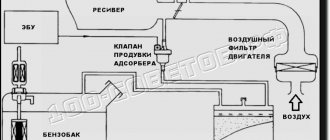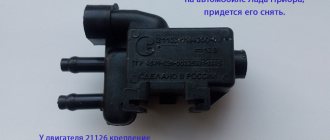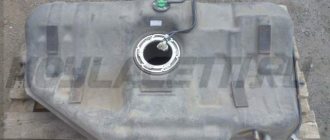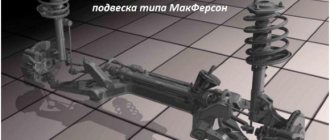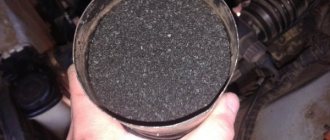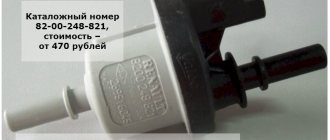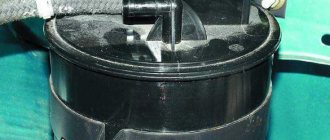The gas tank of any car always contains vapors formed due to a decrease in atmospheric pressure or heating of the fuel. In order to prevent the leakage of fuel vapors into the vehicle, a special gasoline vapor recovery system (VPSU) is installed. Thanks to it, the vapors retained by the adsorber (essentially activated carbon) enter the intake manifold and burn in the engine cylinders. To regulate the amount of gasoline vapor coming from the adsorber to the manifold, a special solenoid valve is used.
Principle of operation
The adsorber itself allows fuel vapors to accumulate in a special place - the separator. As a result, gasoline turns into condensate and goes back to the tank. Vapors that have not undergone treatment go through double valves of the system, one of which prevents fuel from spilling out during an emergency (for example, a coup), and the second “is engaged” in regulating the pressure in the tank. The adsorber purge valve is located under the hood, and the adsorber itself is located on the tank. The control unit ensures the normal operation of the entire system: it ventilates and removes condensation.
Components
In fact, this is a large plastic jar with activated carbon inside, because it is this composition that perfectly fights gasoline vapors. The main parts can be described as follows:
- Separator + gravity valve
- Pressure meter
- Filter part (usually carbon)
- Connecting tubes
- Solenoid valve
As you can see, there is absolutely nothing complicated. Separator - serves to catch part of the gasoline, then sends it back to the tank. Gravity valve - almost never used, but it is needed in emergency situations, for example during accidents, it prevents fuel from overflowing from the tank (for example, when a car overturns).
Design and operation of the adsorber purge valve
The KPA is an electromagnetic locking device that operates from the vehicle’s on-board network. The valve consists of:
- plastic case;
- valve with spring;
- windings;
- metal core;
- connector
When the vehicle's engine is turned off, no voltage is supplied to the valve and it remains in the closed position. That is, on the motor side, the system that captures vapors is blocked. At the same time, the adsorber begins to “collect” vapors. When the power unit starts, voltage is applied to the valve, causing it to open and fuel vapors to enter the intake manifold. As soon as the ignition is turned off, the control unit is de-energized and the pipeline is closed: no vapors enter the receiver.
Cars of a high price category have a more complex evaporation system. Such machines have special sensors that can “calculate” the amount of air and vapor as a percentage. This allows you to more accurately control the supply of gasoline to the injector.
Operating principle
When the fuel is heated in the engine, the same hydrocarbon vapors appear, which, according to the laws of physics, rise upward into the separator, where most of them condense (return to a liquid state and flow back into the fuel tank, i.e., fuel savings occur). Residual gases are transferred through a steam line to an adsorber filled with activated carbon, which neutralizes them.
While the engine is running, there is another option for getting rid of harmful vapors - by redirecting them from the intake pipe. The temperature there is quite high, and the gas simply burns.
The adsorber is located under the hood, in the VAZ 2110 - in the near left corner. The adsorber looks like a small cylinder with a lid.
Adsorber design
- separator;
- gasoline drain pipe;
- steam outlet tube and hose;
- purge valve;
- gravity valve;
- adsorber
Signs of a malfunction of the control unit
First, start the engine: at idle or in cold weather, you will hear a characteristic, barely audible chirping sound. It indicates that the valve is working properly. In order not to confuse this sound with the noise from a working timing belt, sharply press the gas. The character of the chatter should not change. The following signs indicate a malfunction of the control unit:
- lighting of the CHECK signal on the instrument panel;
- determination of error PO441 during testing;
- increased gasoline consumption;
- unstable operation of the power unit when driving;
- unstable idle;
- increase in CO2 content;
- a hissing sound when unscrewing the tank lid (a vacuum has appeared);
- the appearance of a fuel smell in the cabin.
Valve check on site
You will need a tester (voltmeter, multimeter) and a screwdriver. The KPA itself is installed on the radiator frame. The device can be recognized by seeing two tubes approaching it, through which the evaporation moves. Further:
- disconnect the electrical connector from the control unit by releasing the block lock;
- using a multimeter, check for the presence of voltage by touching the negative (black) probe of the device to ground, and the red probe to “A” (the letter on the block connector);
- turn on the ignition: the multimeter should show the vehicle's on-board voltage. If not, check the wiring.
How to check the adsorber valve removed from the car
You need to take a medical syringe of suitable volume, simply pull out the piston 2-3 cm and connect it to the outlet fitting. If you press on the piston, it will move with difficulty, which indicates that there is pressure in the valve. Now connect the battery to the electrical part of the control unit and press the piston again: the resistance should disappear. If this does not happen, you will have to buy a new valve.
What is an adsorber, what task does it perform, what problems can arise, we’ll talk about this and much more in today’s article.
Many car owners have no idea, let alone the structure of the system, and sometimes even its existence. Therefore, the goal of this article is to “put everything into perspective,” including finding out how the device works, as well as where it is located.
Why do you need an adsorber?
It was originally created as a tribute to environmental standards, more precisely under EURO2. By and large, the motor can be configured so that it can do without it. But, taking into account modern standards, vapor leaks are unacceptable. Plus, the adsorber does not allow fuel vapors to enter the cabin, which, as you understand, is also unpleasant. If on old cars, still of the carburetor type, such a system did not exist, in principle, on all modern injectors, it is mandatory.
What is the adsorber and where is it located?
The adsorber is structurally a cylinder, a hollow one, inside of which there is a so-called filter component. The adsorber also consists of a number of additional modules, for example:
• The first is the container in which the filter is placed.
• The filter element is often simple granular activated carbon.
• Separator, a device that receives and sends retained fuel vapors back to the tank.
• Magnetic valve responsible for changing operating modes.
• The gravity valve prevents fuel overflow if the vehicle rolls over.
• Various connecting hoses and tubes.
Perhaps one of the main elements of the entire adsorbing system is the magnetic valve. The mode of operation and the change of modes depend on it. That is, it is responsible for the timely switching of the accumulation mode, when vapors accumulate in the tank, to the mode of transferring vapors back to the tank.
Is it possible to remove
Some motorists neglect environmental standards and remove the adsorber valve. The words are basically like this: “why do I need it, the car has become slower, the consumption has become higher, I’ll throw it away altogether.” But realistically, is it possible to do this? Will this make the car worse?
It is worth understanding that a working system does not affect the operation of the engine at all, and even saves a little fuel, because the vapors that remain in the main body are then burned out in the engine. Of course, you should not expect that the savings will be huge, but you get a few kilometers of mileage.
Of course, you can clean it, the car is simply OK with it! It will even be better, because the evaporation from the tank will not condense (purify), but will go directly into the atmosphere. That is, you kind of remove all the cans - valves and give an open air flow to the tank.
Physically, they do it this way: they hang a fine filter from a carburetor VAZ on the hose from the separator, and gasoline vapors escape into the atmosphere. The hose from the adsorber valve is blocked, the engine is flashed ( chip tuning ), otherwise an error will appear, that’s all!
However, there are also disadvantages to this:
- For example, the cabin will often smell of gasoline, and fumes will (often) go into it.
- The atmosphere is polluted with light hydrocarbons
- There will be a smell of gasoline next to the car (although this is debatable)
Pros of unplugging:
- Frees up space in the engine compartment, the can takes up quite a lot of space
- Unstable idling goes away
- No need to pay a lot of money for a new adsorber and its valve
I think the system is quite useful; personally, I was often annoyed when a carburetor car smelled of gasoline, wherever possible. If you inhale and then get a headache, this system allows you to avoid this, saves fuel a little and does not pollute the atmosphere.
This is where I end, I think my article was useful to you, read our AUTOBLOG, subscribe to the channel.
(
32 votes, average: 4.47 out of 5)
Let's consider in simple language how the adsorber works on a car, what can be malfunctioning with the adsorber, and also how easy it is to check the adsorber valve.
Many car enthusiasts do not know at all what an adsorber is, much less why it is needed and whether it is installed on their car. Also, most people underestimate this unit and consider it secondary in the design of the car.
There are also misconceptions in understanding the operating principle of the adsorber purge valve.
Removal and inspection
2. Having released the latch, disconnect the wiring harness block from the canister purge valve.
3. Connect the negative voltage probe (to the car body).
4. Turning on the ignition, use a voltmeter to measure the supply voltage at terminal A of the wiring harness block (the pins are marked on the block).
Comment. The voltage at the terminal must be at least 12 V. If the voltage does not flow to the block or it is less than 12 V, it means that the battery is discharged, the power circuit is faulty, or the ECU is faulty.
5. Use a Phillips screwdriver to loosen the clamp securing the hose to the canister purge valve.
6. Remove the hose from the valve nozzle.
Advice. If the hose on the nozzle is seated tightly and cannot be disconnected, then you can remove the valve from the adsorber and, by rotating the valve, remove the hose from it.
7. Using a screwdriver, remove the valve from the adsorber.
8. We apply 12 V voltage from the battery to the valve terminals (“+” to terminal A, “-” to terminal B).
Comment. When voltage is applied to the terminals, the valve should open with a characteristic click. The faulty valve must be replaced.
There are problems, but everything is whole
Having the above symptoms, and having checked the integrity of the hoses, we move on to the adsorber valve. How to check it?
1) First of all, disconnect the negative terminal from the battery;
2) Remove the absorber (in most cases it is located on the right side of the engine near the car’s air system);
3) Now turn off the electrical power to the valve itself;
4) Remove the hoses (inlet and outlet);
5) Then we try to blow air into the system through the valve (into the holes for the hoses);
6) If it is working, then when the power is removed from it, it will be blocked, i.e. You won't be able to blow it out;
7) Check further. We connect two wires from the battery to the power contacts on the valve. At the same time, you should hear an opening sound (click);
8) When connected to the source, we try to blow air into it. It should work without problems, if not, then it is closed;
9) Reset the power, if it closes again, then it is 100% working.
By checking the adsorber valve in this way, you can determine its performance at almost 100%. Of course, there may be nuances in which this will be more difficult, but the principle is the same everywhere. Thus, we have described in detail how to check this device.
If it is faulty, then you need to buy a new one - the cost is about 2000 rubles, so before you immediately change it, check it. If the problems lie in the operation of the electronic control unit, then this is a completely different story and everything becomes much more complicated.
Now a short video of a VAZ engine.
I’ll finish here, read our AUTOBLOG.
(
10 votes, average: 4.10 out of 5)
Source

